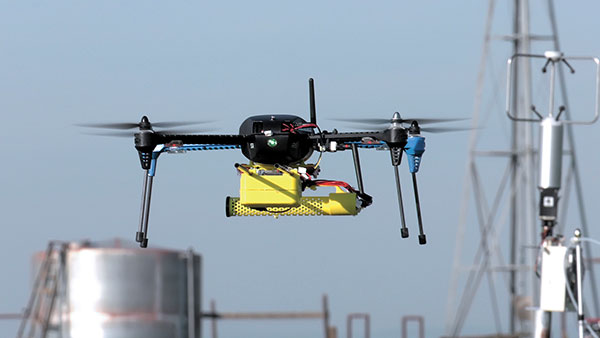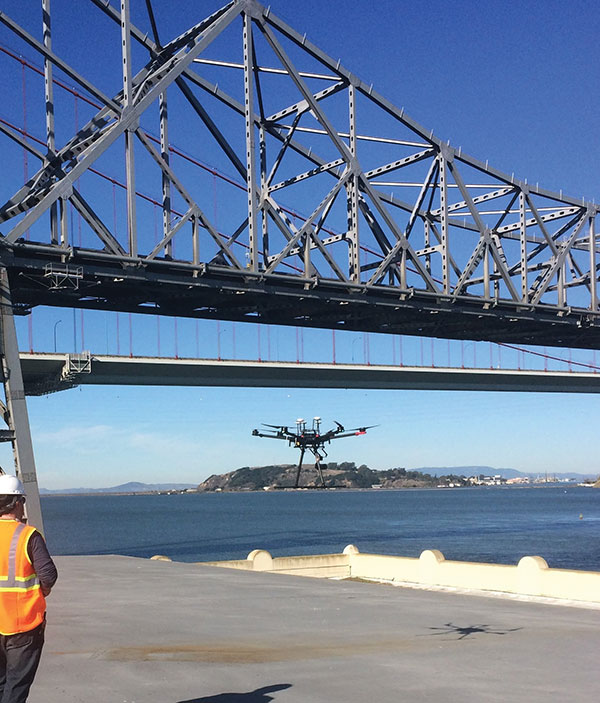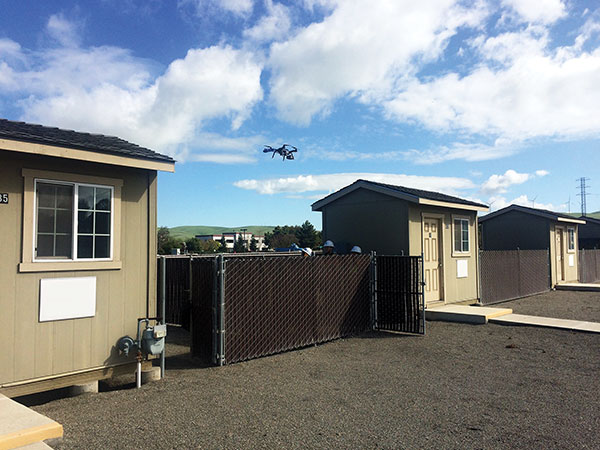October 2018, Vol. 245, No. 10
Features
Drones: Flights of Fancy or Future of the Energy Industry?
By Richard Nemec, Contributing Editor
As wildfires again ravaged much of California and other western states this summer, energy industry professionals like Pacific Gas and Electric Co.’s (PG&E) Ned Biehl and Francois Rongere could hardly imagine what their counterparts just a few years earlier had to deal with amid similar natural disasters without drones.
Unmanned aircraft systems (UAS), which robotically assess dangerous situations with little or no human risk, have literally helped shrink the job of maintaining regular monitoring of energy infrastructure spread over thousands of square miles.
During the record onslaught of nearly two dozen wildfires in Northern California in October 2017, Biehl, PG&E’s director of aviation services, was predicting that drones represent “an evolving technology that will only provide greater value and enhanced safety into the future.”
He is convinced the UAS technology is what allowed PG&E to support first-responders and ensure a safer restoration process during the horrific fires that California officials call the “new normal.”
The San Francisco-based combination utility maintains an aviation service unit working closely with the Federal Aviation Administration (FAA) and California Cal FIRE units. The utility aviation unit in turn works with an internal cybersecurity team for protection of tracking and identification of data.
Operating from a series of utility bases in and around the hardest hit fire areas in Santa Rosa and Napa, Calif., four PG&E teams conducted multiple morning flights over the fire zones during the wildfire response, capturing video and still images of the utility equipment during the cauldron. Each team was comprised of a pilot, an observer/co-pilot from the drone vendor, an equipment assessment expert, and a safety officer to ensure public safety, according to Biehl.
Information was shared with various base camps in multiple counties, along with the PG&E emergency operations center in San Francisco, assisting the utility’s response efforts to restore service and rebuild infrastructure. Before the fires, PG&E had never deployed drones in anything other than single applications, such as the mapping of a substation. The wildfires provided the real-world opportunity to expand those applications.
Flash forward to July 2018 and Rongere, PG&E’s manager of gas operations research, development and innovation, is talking about automation and robotics and how drones are an important part of the puzzle for increasing the quality, timeliness and preventive value of asset inspections by energy companies like PG&E. “Eventually, drones are destined to be part of everyone’s back yard,” he said matter-of-factly.
A little less than a decade ago, Rongere came from his engineering position at France’s largest electricity supplier, Electricite de France, to help establish PG&E’s research, development and innovation department as a means of getting more complete control of an energy production/delivery system encompassing 70,000 square miles, 16 million customers, 80,000 miles of natural gas pipelines and 6,700 miles of gas transmission pipelines, 42,000 miles of distribution pipes, and 30,000 miles of gas service lines.
PG&E sees the UAVs as a platform, and especially a robotic platform that can be used to do inspections, Rongere said. Leak surveys are one application, but above-ground pipelines in remote areas are another, he said. “Typically, they are part of bridges, and they are very difficult to inspect for corrosion, so we use UAVs to take very accurate pictures and videos of the pipeline and supporting infrastructure.”
There are several million drones buzzing around U.S. skies and the numbers keep growing rapidly for several years now, according to various sources, including the FAA, which registers the drone operators. By 2020, the FAA estimates there will be more than 7 million of the diminutive aircraft that various industries, such as oil and gas, have strongly embraced. All this has taken place in a generation’s time since February 2002 when the first drone, Preditor, managed to kill a combatant in Afghanistan to fulfill a post-9/11 U.S. military mission near Khost, Afghanistan.
Longer term, the success of UASs will be more dependent on advances in smaller sensors, deep learning/analytics as found in AI, and in robotics. PG&E’s Rongere concurred that this was consistent with his assessment of the future. “We need to transfer more and better sensors from aircraft to robotic, autonomous drones as a better solution,” he said.
A special FAA small drone rule has been effective the past two years and during that time more than 100,000 people have obtained a remote pilot certificate (RPC) to fly a drone for commercial or recreational (not qualifying as model) aircraft.
Under FAA requirements (Part 107), the person flying a drone – or UAS – must have a pilot’s certificate or be directly supervised by someone with one. Most drone pilots get certified by studying online (PDF) and then passing an initial aeronautical knowledge test at an FAA approved testing center; the exam success rate is 92%. People with a Part 61 pilot certificate that have completed a flight review in the previous 24 months, can take a small UAS online training course provided by the FAA to obtain a drone certificate.
Alex Tepper, founder of Avitas Systems, a GE subsidiary, said the current developments take need for a highly trained drone pilot off the table; you don’t need a highly trained inspector trained on drone flights,” he explains. “And this is driving down the costs significantly; actually, it brings it in-house because you don’t need to be a Ph.D. engineer at a major university to fly these drones. Autonomy is now so advanced that you can build the flight path and train the inspectors quite easily in how to perform the inspections in the right way.”
For the future, the drones, themselves, are relatively common place, but the rapidly advancing technologies they carry are what have R&D people in the industry excited. Rongere experiences this at PG&E where most of the 200 projects his group manages have nothing to do with drones, and in fact, can involve the National Aeronautics and Space Administration (NASA) and cutting-edge methane-detecting technologies that are tied to projects at the CalTech Jet Propulsion Laboratory in Southern California.
PG&E and NASA JPL worked together on the methane detector for the Mars lander, and Rongere said the advantage of this sensor is its small size and light weight, two essentials for any technology attached to drones. “It is very small, very light and has low power consumption,” he said, emphasizing that makes it an ideal sensor for mounting on a drone.
The technology uses a laser beam bounced between two mirrors with specific wavelengths and wavelines that correspond to the spectrum for methane, Rongere said.
“We are testing it mostly on small UAV units on gas system equipment.” PG&E is starting by using it to monitor gas equipment at regulator and compressor stations with the idea to expand it to flying over pipelines eventually, he said. “It will go to transmission pipelines first and then distribution. We need to take time for people to get used to having a UAV in their back yard.”
Outside of the oil and gas industry, various service and technology behemoths are seeing increased roles for drones and technology innovations such as AI and analytics. They vary from heavy industrial equipment supplier Caterpillar to industrial conglomerate, General Electric (GE).
Avitas Systems’ Tepper thinks people and businesses generally are looking at drones too narrowly, speaking from his own experience of having to bring the UAS business into GE at a time when the new CEO is selling off many of the conglomerate’s businesses.
“For us it is a more holistic strategy in which drones are one of many tools we can use,” he said. “Drones can play one role, but there are a whole bunch of other paths and inflexions they can’t replace. Even for the applications that we use drones for, it is not the data capture side [drones], much more important are aspects like AI and visualization, and integrating them into upstream or downstream operations.”
There is a wealth of data and R&D surrounding efforts to have autonomous and semi-autonomous drones. JPL and NASA are very interested in something called “stereoscopic vision,” two cameras to capture depth in the image and rebuild a 3-D image from there. JPL is interested in looking at collision avoidance, automatic navigation based on the stereoscopic technology. PG&E’s Rongere, who has worked in this area, said there are some major technology players working to advance this technology.
With similar ties to the NASA JPL methane-sniffing technology, the Virginia-based Pipeline Research Council International (PRCI) has been overseeing two drone-related research projects and one of them involves the JPL work. Carrie Greaney, PRCI program manager for both projects, sees them as contributing to the ongoing advancement of UAS work.
Greaney noted the JPL-related project, Open Path Laser Spectrometer (OPLS) technology development, is still not classified as publicly available research as is her other drone project. OPLS methane-sniffing technology developed as part of a right-of-way (ROW) project with the space engineers, and has now been licensed to two commercialization partners, RKI Instruments and SeekOps. The end goal is to develop a series of commercial products using parts-per-billion methane sensing from small UASs and hand-held instruments.
PRCI’s Greaney said the OPLS technology has raised the importance of developing more miniature gas sensors to address fugitive emissions detection and geologic locations. She also noted that the current commercially available versions of the technology are for methane detection only. “PRCI is still working with JPL on validation for a combined methane/ethane version of the sensor system that could help eliminate false indications of biogenic natural gas,” he added.
The second PRCI research effort Greaney helped oversee has tested the applicability and effectiveness of UAS use in pipeline monitoring and surveillance, which is now publicly available research that was completed earlier in 2018. The work has helped verify the use of long-range UAS for pipe patrols, successfully demonstrating what Greaney calls “the interoperability of PRCI’s Automated Threat Detection System (ATDS) payload.” As a result, other sensing capabilities will be integrated into ATDS, she said.
“Testing results demonstrated that a UAS can be configured with technology systems that provide meaningful data and information on a range of pipeline operating and integrity parameters,” said Greaney, noting that here was an emphasis on the safe operation of larger UAS platforms flying Beyond Visual Line of Sight (BVLOS) of the pilot/operator, which is crucial for systems covering thousands of miles.
PRCI’s work included a series of test flights to demonstrate that UAS can be applied to day-to-day functions of energy pipeline integrity management, and that they can operate safely, effectively and in full compliance with all federal and state laws or regulations, Greaney said.
BVLOS is where the largest potential expansion of UAS services to various areas around the nation resides, including potential in some of the major oil and gas basins, such as the Bakken Shale in the Williston Basin in North Dakota. “Density of assets is an important factor because it changes the type of drones used and how they are used,” said Avitas Systems’ Tepper, citing the difference between a downstream refinery compared to a complex of midstream processing plants and pipelines.
For PG&E’s Rongere BVLOS is important for the energy industry because the industry’s assets “are everywhere, and we don’t want to have to drive every 12 miles just to re-launch the UASs; that’s not cost effective. It is only cost effective if it is beyond-the line-of-sight.” In the meantime, he points out that there are some telecommunications and cogeneration issues tied to BVLOS that need to resolve, but if those hurdles can be overcome to the satisfaction of regulators, the application of BVLOS will grow, he said.
Upstream and downstream are what operators like Tepper consider vertically oriented, meaning the work can be done on a “line-of-sight” basis typically. “Pipelines are tougher because you have to go beyond line-of-sight,” Tepper said. And that sort of work is “moving along relatively slowly from a regulatory perspective in the United States.”
Harris Corp., a UAS consultant to the FAA and others, breaks down the drone network of services into command/control, detect/avoid and value-added as enabling BVLOS as a strategy. Land and satellite radio links make up command/control while the detection/avoidance capabilities come from ground- and air-based sensors, along with air space visualization, and the value-added can be payload data, voice communications, and finally National Airspace System (NAS) integration.
Eventually, BVLOS allow for several real-time advantages, according to Harris:
- Fusing multiple surveillance data sets through high-accuracy detect/avoid solutions
- Providing a mission-critical command/control link delivered by an aviation-grade communications network
- Transferring sensor data through a highly secure payload data link
Supporting flight operations integrated with NAS and local aviation information.
A key area for drones’ future growth can be found in advances in autonomy in deploying the UAVs, which allows their use without the need to hire high-priced, experienced pilots. Then, in turn the greater autonomy is leading to more of economy in their deployment and use, Tepper explains.
In the past five years, per-flight drone charges typically have decreased from above $10,000 to under $1,000, Tepper said. “There are a bunch of factors involved, one of which is there has been a massive influx of new drone operators. The supply has increased tremendously, and it is not as specialized as it once was. It still requires FAA certification, but is now fairly easy to pass that test. It is a lot less rigorous than it once was mostly because the technology is so much more advanced.”
This is an example of where the artificial intelligence is making huge advances, Tepper notes. Reduced labor and maintenance costs are the keys for more companies deploying drone platforms, he reiterates, along with various safety considerations. With robotics and drones you remove the human safety considerations from the work.
At PG&E, Rongere said the drones themselves are not part of the overall economics of UAS. “The economics are the time and people you need to deploy the drone, so that is why it has to be autonomous,” he said.
Today, as defined by the FAA you need a person with a pilot’s license, plus another observer, so two people watching terminals for UAVs. A pilot and observer for an aircraft makes the costs about the same, Rongere said.
“The aircraft itself is not the major cost. For us, the economics of the drone is really what comes from the regulators – the ability to have control and deploy by personnel that’s not an expert, so we don’t need to have a high-skilled, high-priced pilot all the time. That’s a key factor for the economics. Ideally, what you want is a robotic platform that doesn’t require human personnel to operate it.”
Reduced labor and maintenance costs are the keys for more companies deploying drone platforms, he reiterates, along with various safety considerations. With robotics and drones you take the human safety considerations out of the work. “Safety is an important consideration,” Rongere said.
PG&E and other officials who talked to P&GJ showed concerns that with all the cost-cutting, accelerating of pilot training that the drone space looks like it is filled with corner-cutting, rules — bending and generally making safety tougher to maintain. To clarify this point, PG&E gas system spokesperson Melissa Subbotin wanted to offer some “finer points.”
“Our testing of drones and operational use isn’t intended to replace employees but rather use technology to enhance our efficiency – especially when it comes to accessing harder-to-reach areas.,” Subbotin said. “In fact, if anything drones may present an opportunity to further expand jobs.” P&GJ








Comments